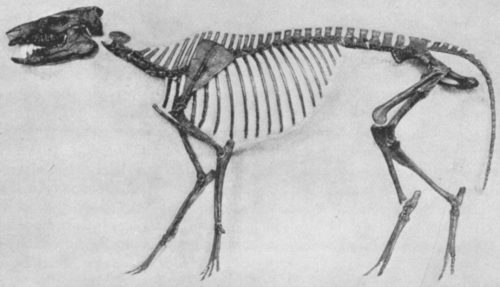The earliest evidence of this little horse is found in the middle Eocene of Wyoming, about 2 million years after the first appearance of Hyracotherium. The two genera coexisted during the Eocene, although Orohippus fossils are not as numerous or as geographically widespread as those of Hyracotherium.
 Where & When?
Where & When?
Fossils of Orohippus have been found in Eocene sediments in Wyoming and Oregon, dating from about 52-45 million years ago.
Did Orohippus look down on other animals of its time?
Professor O.C. Marsh did not explain why he named this animal Orohippus (“mountain horse”), though it may relate to the fossils being found at a place in Wyoming called Grizzly Butte. A butte is an isolated hill or mountain in an otherwise flat landscape.
If he had been inspired by a different part of the locality name, you might instead be reading about Ursahippus, the “bear horse.” Contrary to its name, Orohippus did not live in the mountains.

Orohippus was slightly larger than Hyracotherium, but shared its generally primitive postcranial skeletal structure. For example, as in humans, the lower limb bones of the forelimb, the radius and ulna, of Hyracotherium and Orohippus are distinct and unfused.
This is the primitive condition for mammals, and permits rotational movement at the elbow and wrist joints. This condition is retained by animals such as small forest dwellers who must maneuver over uneven terrain.
In its postcranial skeleton, Orohippus differs from Hyracotherium by having more enlarged middle digits on its fore and hind feet, and by displaying a complete loss of the first and fifth (thumb and pinkie) toes of the hindlimb.